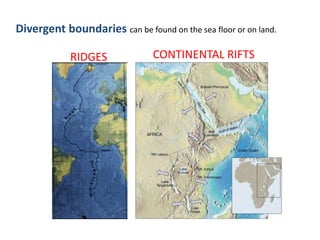Earth's dynamics. Plate Tectonics for secondary education.
- 1. The Theory of Plate Tectonics
- 2. Scientific precedent: Continental Drift Alfred Wegener: 1915. “The Origen of Continents and Oceans”
- 10. •What’s wrong with Continental Drift? •How long did we wait for a new theory? •How did it come?
- 11. During the second half of the 20th century: • Seismometers network. • Submerged relief of the oceans. •Age of the rocks of the ocean floor. •Paleomagnetism of the ocean floor. •Distribution of earthquakes and volcanos. Global Tectonics
- 12. Main concepts • The lithosphere is divided into great blocks. • Lithosperic plates are dynamic. • The ocean floor is continually generated and destroyed.
- 14. Types of plate boundaries • Divergent or constructive boundaries. • Convergent or destructive boundaries. • Transform or passive boundaries.
- 16. Divergent boundaries What do you see here? Come on, make the effort! What geological phenomena are likely to occur here? Would the study of the rock age help?
- 17. Divergent boundaries •Molten material rises up and solidifies on the surface, pushing the 2 plates in opposite directions. •New lithosphere is being formed here, so: • Do plates increase their size? • Is the Earth’s surface increasing?
- 18. Divergent boundaries can be found on the sea floor or on land. RIDGES CONTINENTAL RIFTS
- 19. What is this?
- 20. Transform or passive boundaries • Fractures where 2 plates slide horizontally against each other. • Is lithosphere being created here? • What geological phenomena are expected? • Do you know any of these transform faults by name?
- 27. Convergent or destructive boundaries • Two plates moving towards each other interact. what happens then? • 3 types according to the composition of the plates in the area of collision: 1. Continental and oceanic. 2. 2 oceanic plates. 3. 2 continental plates.
- 28. Types of destructive boundaries Could you define subduction? How do we know this is real?
- 29. Depth of hypocentres The further you go from the trench, the deeper the hypocentres are plane of subduction or plane of Benioff.
- 30. Oceanic-Continental • Oceanic plate subducts under continental. • Quakes along a sloping plane. • Andean or marginal mountain ranges with active volcanoes.
- 31. Oceanic-Oceanic • The oldest one subducts. Why? • Friction+high T melt the rocks. •Active volcanoes form an island arc.
- 32. Continental-Continental Continental lithosphere can’t subduct. What now? A mountain range is formed. Earthquakes. What about volcanism?
- 35. Types of boundaries. Summary. Type of boundary Tye of movement Ocean floor Landform produced DIVERGENT Separation Creates oceanic lithosphere Ridges and continental rifts Destroys oceanic lithosphere Neither creates nor destroys Trenches, island arcs and mountains Transform faults CONVERGENT Collision TRANSFORM Lateral displacement
- 36. The Wilson Cycle John Tuzo Wilson (1909-1993): • At least, two geological processes of rifting and reuniting of supercontinents. • This cycle brings together all the phenomena studied so far. • Can be organised in 3 stages: 1. Continental rifting. 2. Expanding ocean. 3. Continental collision.
- 37. Activity: Organise these images in a cycle.
- 40. Continental fragmentation. Plate dynamics and heat under the continent can fracture the continent. First, it bulges and breaks, then, it sinks down and a CONTINENTAL RIFT is formed.
- 42. Formation of an expanding ocean. The Atlantic ocean is an example. Its size is increasing steadily due to the production of new oceanic lithosphere. What’s going on here?
- 43. Closing of the ocean basin and continental collision. The oceanic lithosphere near the edge of the continent fractures and stars to subduct. Why? Increased density. Weight of sediments.
- 44. The evidence for the theory of plate tectonics During the second half of the 20th century: • Seismometers network. •Distribution of earthquakes and volcanos. • Submerged relief of the oceans. •Age of the rocks of the ocean floor. •Paleomagnetism of the ocean floor. •Laser and GPS measurements. Global Tectonics
- 45. Distribution of erthquakes and volcanoes
- 46. Mapping of the submerged relief
- 47. Study of the age of the rocks of the ocean floor
- 48. Study of the age of the rocks of the ocean floor
- 49. Paleomagnetism of the ocean floor
- 50. Laser and GPS measurements
- 52. How do we explain the movement of the plates? 1. Convection Currents. 2. Push exerted by new materials in the oceanic ridges. 3. Pull due to the weight of sinking plates in oceanic trenches.



















































